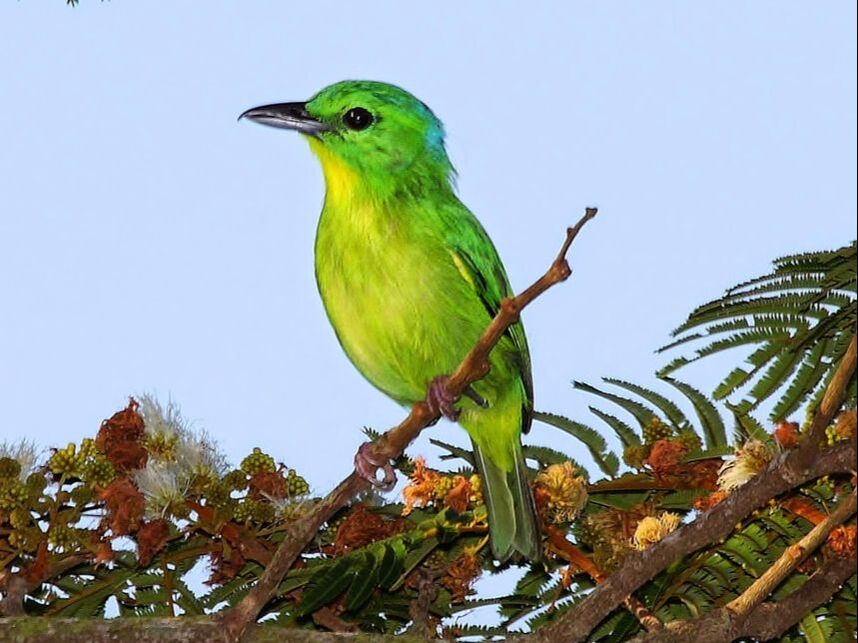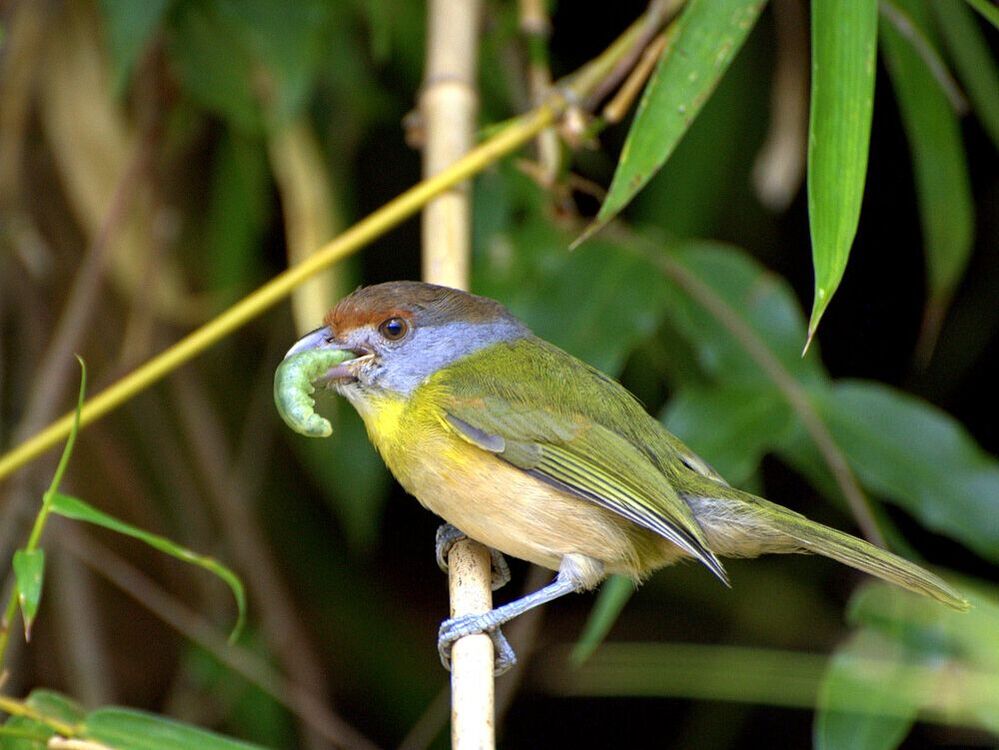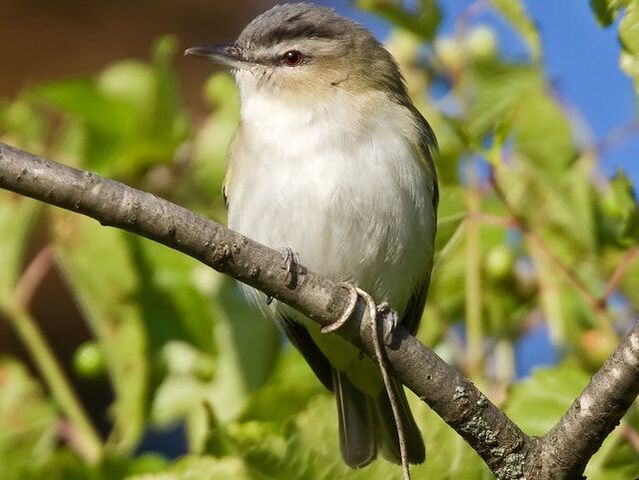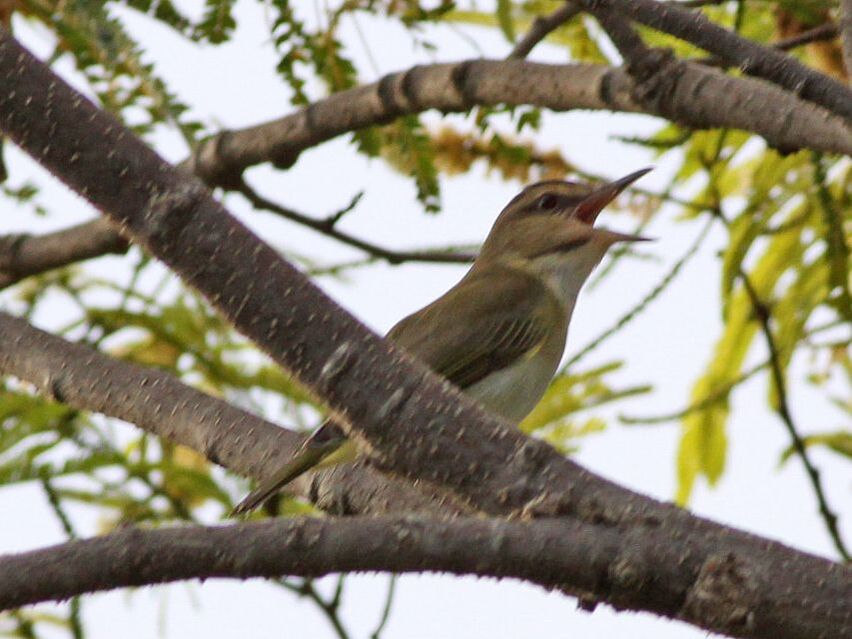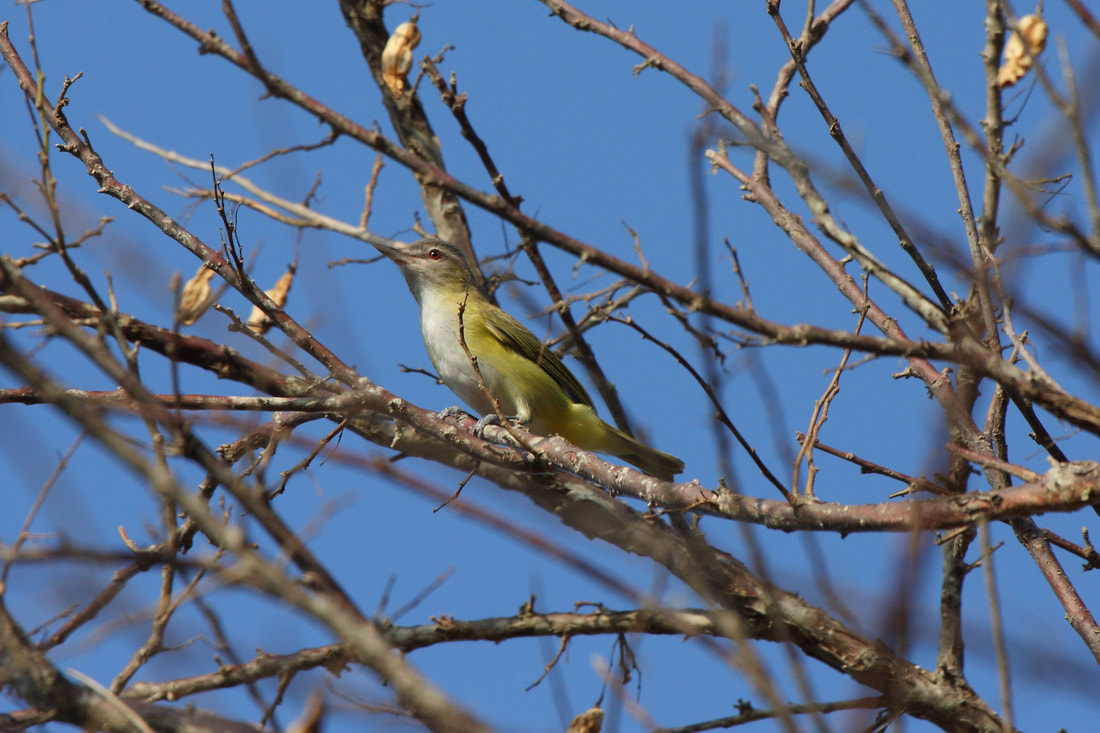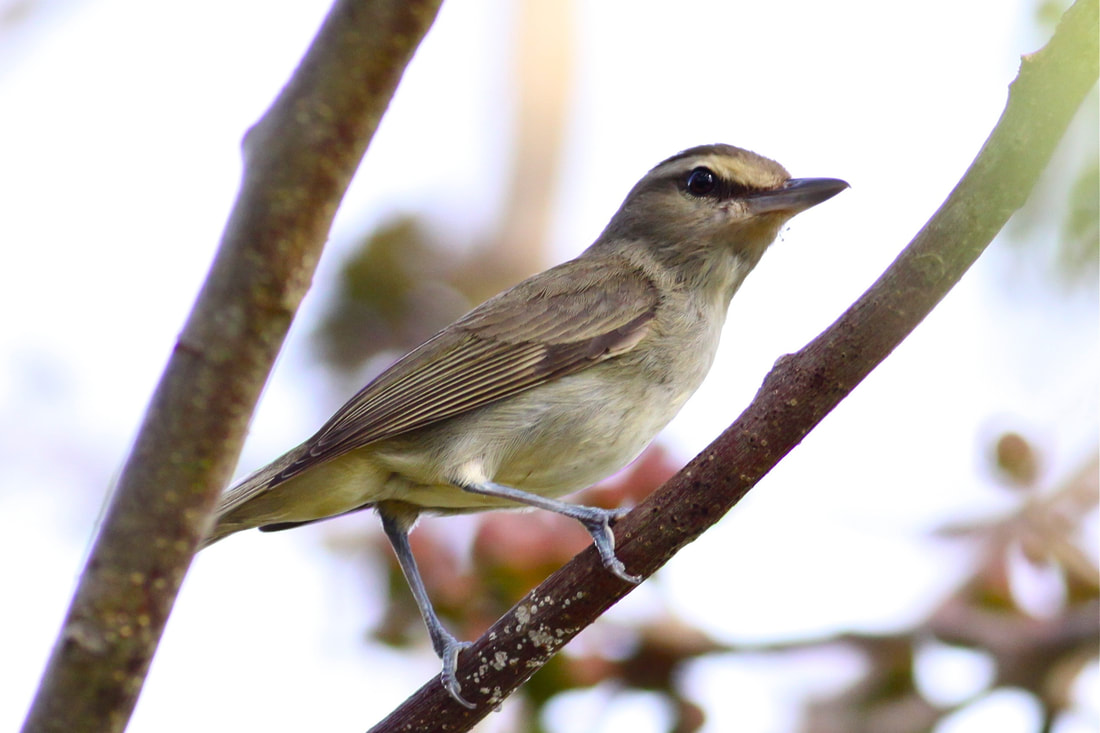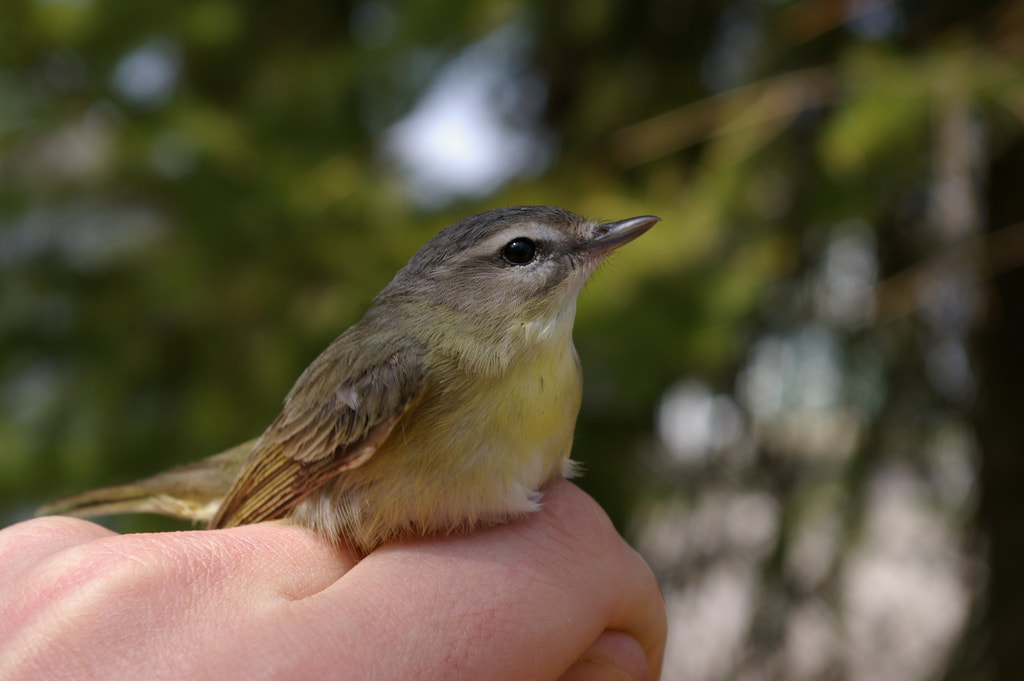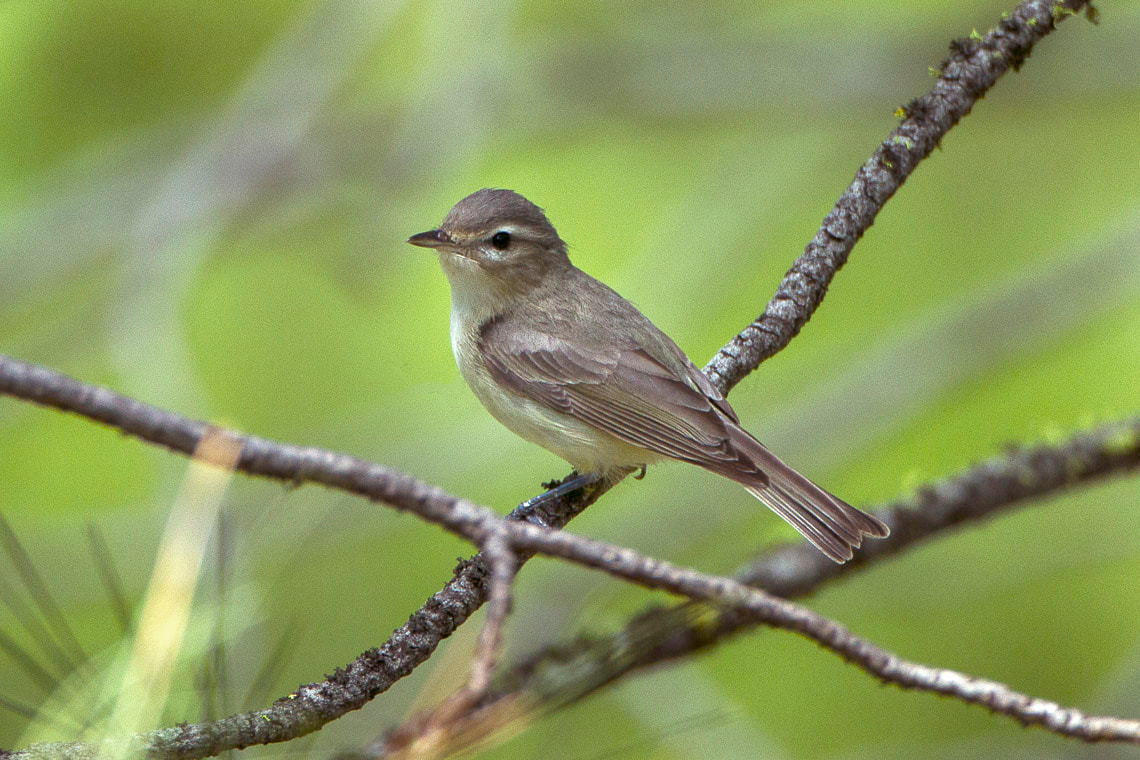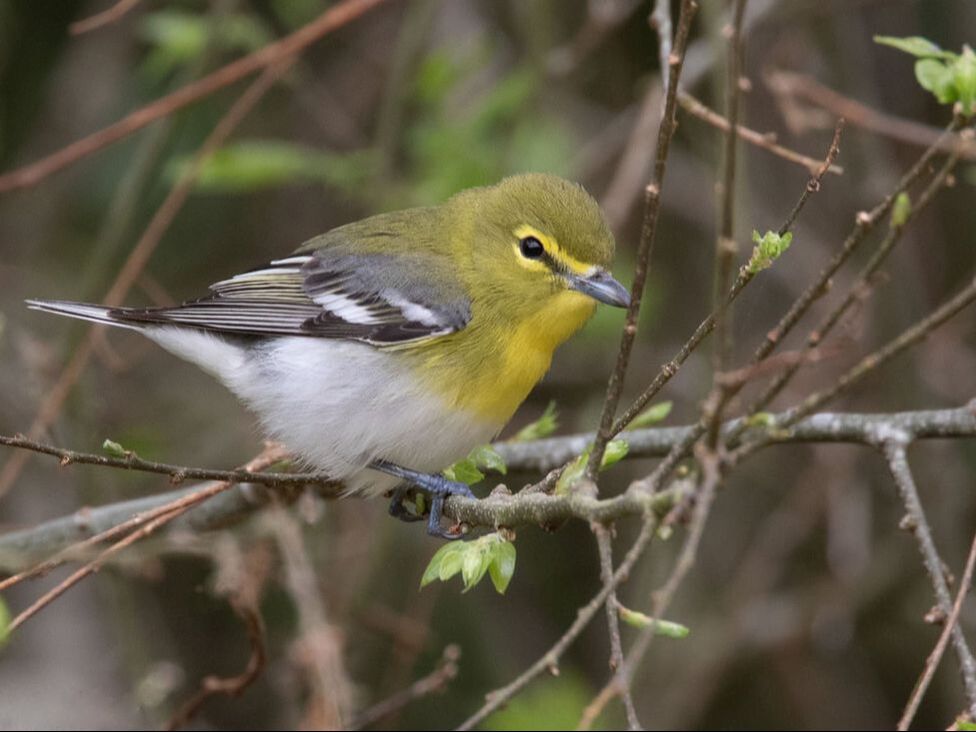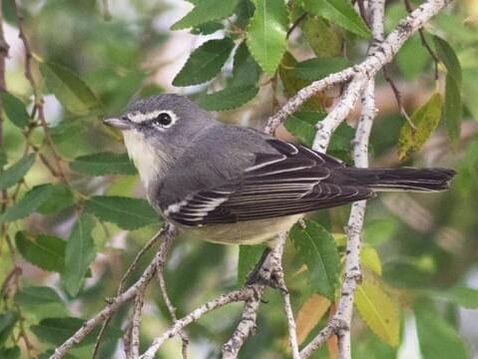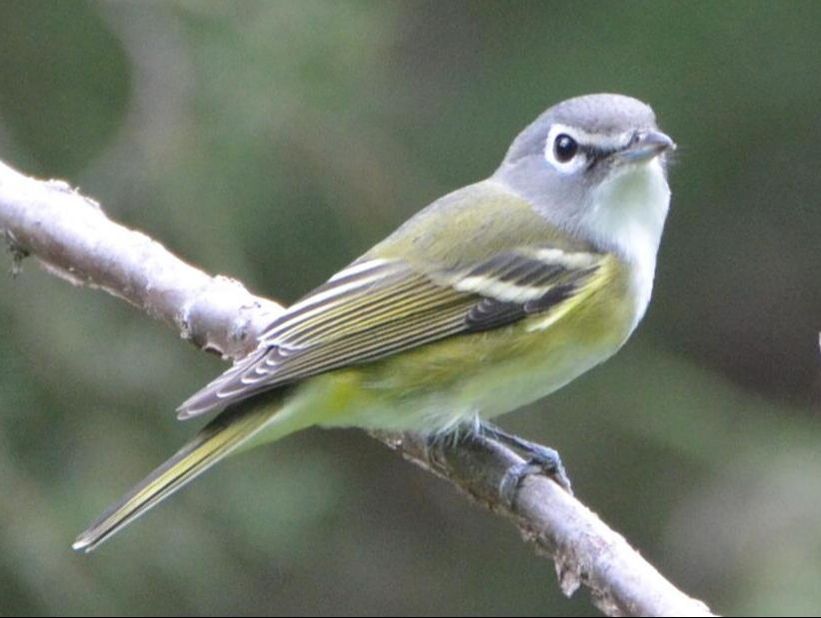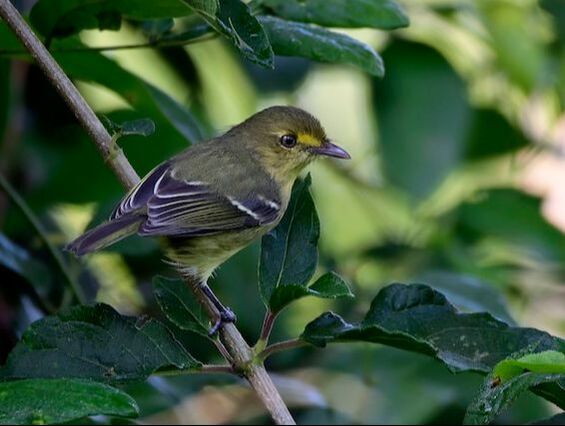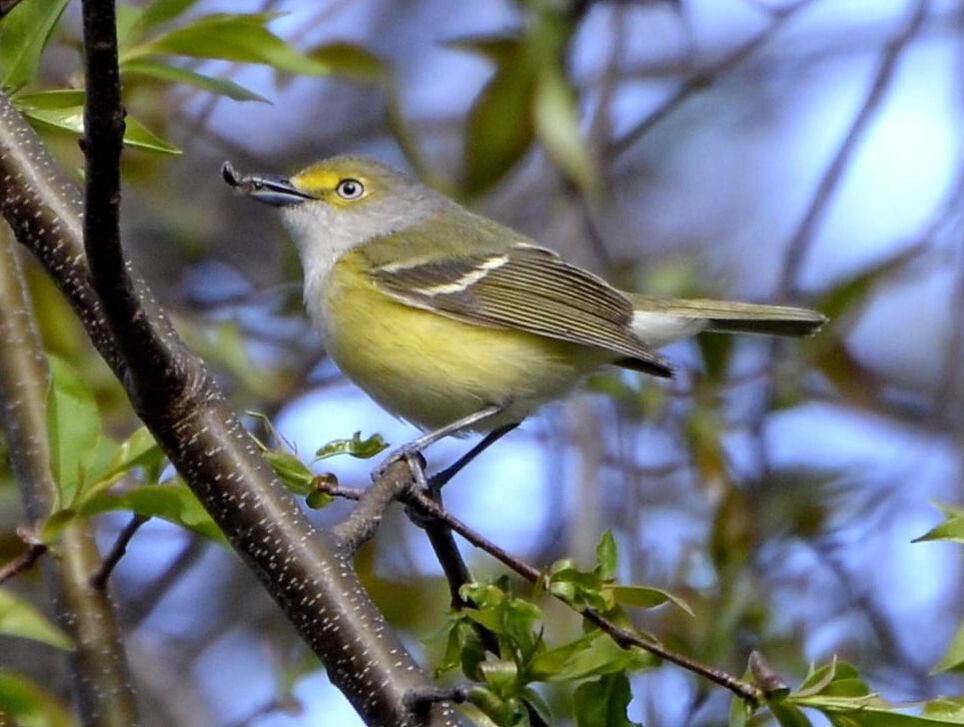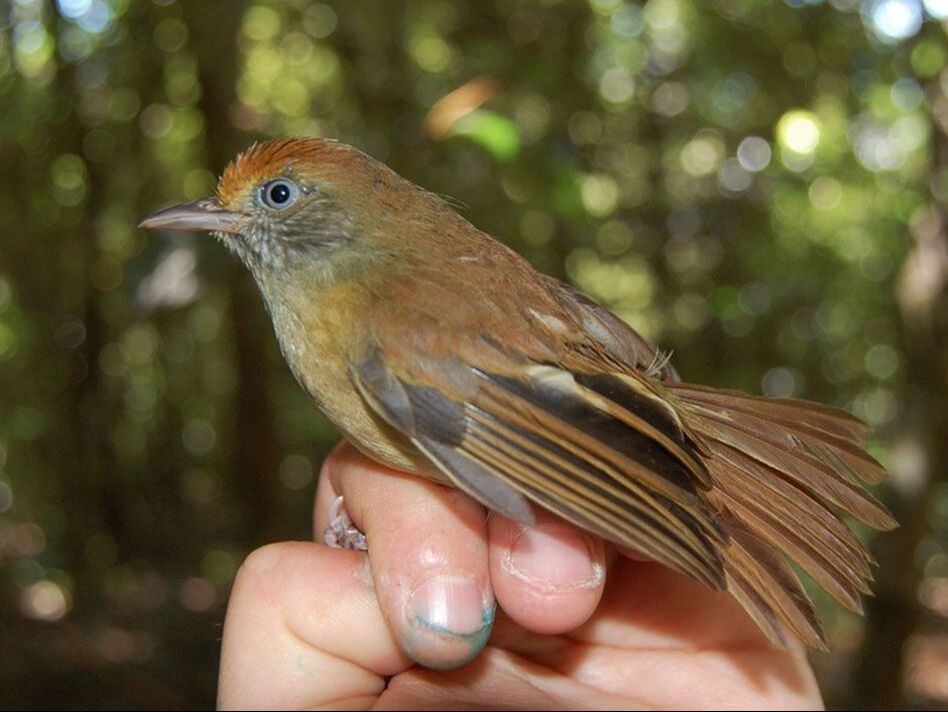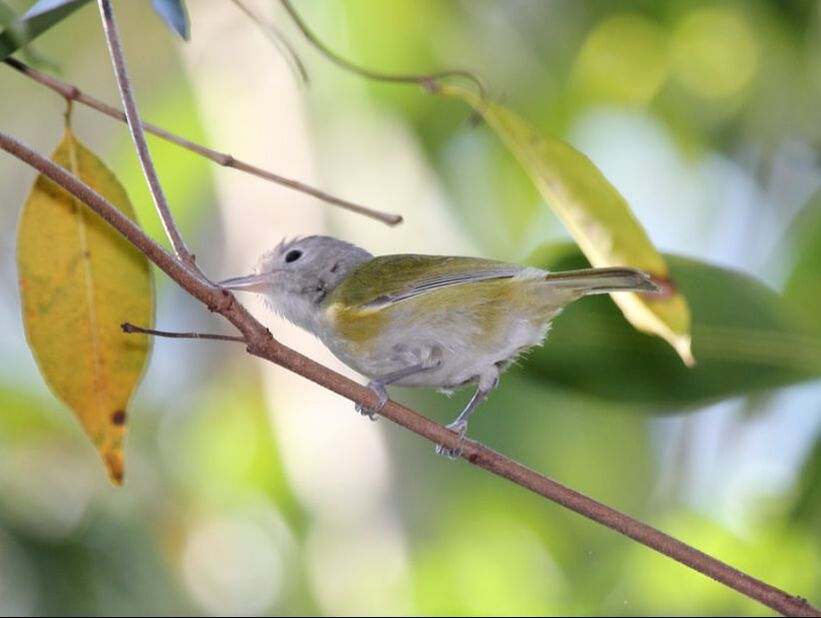Vireos - in Belize
Green Shrike
Green Shrike - Chunky, sluggish green bird of humid evergreen forest in tropical foothills and lowlands. Rarely seen, but often heard singing monotonously from the canopy. Forages mainly at middle to upper levels, at times with mixed-species feeding flocks. Plumage is bright green overall, blending well with the foliage. Note the yellow throat and stout gray bill; turquoise-blue crown usually not visible from below. Similar Blue-crowned Chlorophonia has brighter yellow belly and stubbier bill.
BELIZE HABITAT - Canopy and sub-canopy within primary broadleaf forest interior. Where can you find this bird in Belize? Common dry season resident in interior north to north Cayo; also in west and central Orange Walk. Conspicuous when singing (late Dec. to early June), but recorded much less frequently in rainy season when not singing. It is unclear whether this hard-to-see canopy dweller partially withdraws from Belize in the rainy season or is simply overlooked. |
Rufous Browned Peppershrike
Rufous Browed Peppershrike - A large chunky vireo, widespread in tropical and subtropical wooded habitats. Forages sluggishly, mainly at mid-upper levels, sometimes joining mixed-species feeding flocks. Plumage varies across its range, but all populations have a very stout pale bill, a rusty eyebrow, and pinkish legs; underparts vary from bright yellow (as in mainland Mexico and Central America) to dingy yellow (as on Cozumel Island).
BELIZE HABITAT - Open country with scattered trees and shrubs, roadside brush, forest and second growth edge, pinelands, and occasional mangroves; typically in drier regions. Where can you find this bird in Belize? Fairly common resident on mainland west to central Orange Walk and south through north east cayo to north east Toledo, rarely to south Toledo. Uncommon resident on Ambergris Caye, but absent from other cayes. |
Red-Eyed Vireo
Red Eyed Vireo - Plain olive-green above and whitish below with no wingbars. Red eye of adults is not always easy to see; immatures have brown eyes. Dark stripe through and above eye. Thicker bill than warblers, body about the same size. Found in forested areas with deciduous trees. Tends to sing later in the day than other songbirds. Listen for their monotonous song coming from the treetops. Often with flocks of chickadees and warblers during migration. Winters in South America, where it could be confused with the very similar Chivi Vireo. Best distinguished by voice.
BELIZE HABITAT - Mid to upper strata of tall second growth and forest edge; less often in mature forest. Where can you find this bird in Belize? Very common autumn and common spring transient, early August to late November and late March to late May. |
Black-Whiskered Vireo
Black Whiskered Vireo - Small songbird nearly identical in plumage to Red-eyed Vireo but slightly duller and browner. Drab olive-greenish above and white below with gray cap, white eyebrow, and brown eye. Telltale black whisker mark often difficult to see, but is diagnostic. Hooked bill is rather long for a vireo. Primarily a Caribbean species with limited range in U.S.; breeds in scrubby mangrove forests in Florida. Can be difficult to spot in dense foliage, but listen for song: repeated three-parted chirping phrases that are vaguely reminiscent of House Sparrow.
BELIZE HABITAT - Forest and scrub. Where can you find this bird in Belize? Two records: Half Moon Caye on March 22, 1926 and Ambergris Caye on May 13-18, 2002. |
Yellow-Green Vireo
Yellow Green Vireo - Fairly large vireo with a big bill and a pale eyebrow. Central American counterpart to Red-eyed Vireo of North America. Breeds in tropical woodland and forest of Mexico and Central America, migrating south in September to Amazonia and returning north again in March. Told from Red-eyed Vireo by its less contrasting head pattern, yellow sides and flanks, and brighter greenish upperparts. Monotonous song sounds like a House Sparrow that’s taken singing lessons.
BELIZE HABITAT - Broadleaf forest, tall second growth, forest edge, open woodland with scattered large trees; usually in canopy, occasionally lower. Where can you find this bird in Belize? Common summer resident on mainland (except higher elevations?) and Ambergris Caye, early March to mid-October; occasionally seen in migration on other cayes. Has been considered in the past to be conspecific with Red-eyed Vireo. |
Yucatan Vireo
Yucatan Vireo - Large, big-billed vireo of eastern Yucatan Peninsula, offshore islands, and Grand Cayman. Forages low to high in tropical woodland, thickets, and overgrown clearings; like many vireos, often found eating berries. Rather drab but distinctive, with olive-gray upperparts, dingy underparts, and a broad pale eyebrow set off by a thick black eyestripe thickest forward of eyes.
BELIZE HABITAT - Mangroves and littoral forest. Where can you find this bird in Belize? Common to very common resident on cayes south to Snake Cayes (formerly Sapodillas)_; generally less common along immediate mainland coast south to central Toledo. |
Philadelphia Vireo
Philadelphia Vireo - Small, short-tailed, most similar to Warbling Vireo, but brighter: look for yellow wash on underparts, brightest on throat and undertail, and dark line through the eye that connects to base of bill. Dull individuals can be very difficult to distinguish from Warbling Vireo, but Warbling usually brightest yellow on flanks, not throat. Similar to Red-eyed Vireo but with shorter bill and yellower below. Breeds in deciduous forests, especially areas with younger trees including birches or aspens. Migrates through a variety of wooded and brushy habitats; winters in Central America. Song nearly identical to Red-eyed Vireo. Feeds on insects; especially caterpillars.
BELIZE HABITAT - Various, including scrub, orchards, yards, and early successional and mature broadleaf forest (mid-levels to sub-canopy). Where can you find this bird in Belize? Fairly common transient and uncommon winter visitor, early October to late May. |
Warbling Vireo
Warbling Vireo - Drab gray bird lacks any distinctive features. Eyebrow is slightly paler than rest of head and underparts lack patterning. Monotonous warbling song is heard from treetops, particularly in riparian areas and cottonwoods throughout the summer. Winters in Central America.
BELIZE HABITAT - Mid to upper strata within broadleaf forest; more widespread in migration. Where can you find this bird in Belize? Two believable sight records; Union Camp near Little Quartz Ridge Toledo on April 4, 1992; Crooked Tree Belize on March 21, 1999. Other reports lack convincing documentation. |
Yellow-Throated Vireo
Yellow Throated Vireo - Bright yellow throat and prominent yellow eyering set this vireo apart. Grayish above with bold white wingbars. Burry song phrases ring through the canopy of deciduous woodlands; often favors tall trees near water. Thick, slightly hooked bill characteristic of vireos helps separate this species from Pine Warbler. Winters in Central and South America.
BELIZE HABITAT - Mid to upper strata in mature and old second growth broadleaf and pine forests and forest edge; less frequently in younger second growth forest. Where can you find this bird in Belize? Uncommon to fairly common winter visitor, early September to late April; more widespread in migration. |
Plumbeous Vireo
Plumbeous Vireo - Dull vireo with gray upperparts and white underparts. Relatively thick bill and slower movements separate this bird from other small songbirds. Combination of white spectacles and no bright colors distinguish Plumbeous from other vireos. Resident populations in northern Central America brighter, but not as bright as the slightly larger Blue-headed Vireo, which occurs as a visitor there. Found in mixed forested habitats, particularly dry, open coniferous forests. Feeds on insects.
BELIZE HABITAT - Sub-canopy to canopy in mature pine, broadleaf, and mixed forests. Where can you find this bird in Belize? Fairly common resident in Mountain Pine Ridge above 2,000 feet in Maya Mountains; also discontinuously in coastal plain in east central Stann Creek. The small subspecies in Belize, V.p. notius may be an endemic or near endemic, but the subspecific affinities of this and nearby populations in Guatuemala and Chiapas are still unclear. It is intermediate in plumage characters between other races of Plumbeous Vireo and Cassin's Vireo. It is likely to be more closely related to Plumbeous Vireos in the nearby highlands than to the Cassin's Vireo, which nests no closer to Belize than Baja Caiflornia, Mexico. |
Blue-Headed Vireo
Blue Headed Vireo - Attractive vireo with thick white spectacles that contrast with slaty-blue head. Also note greenish back with two bold white wingbars, yellowish sides, white throat, and white belly. Thicker bill than warblers and slightly hooked at the tip. Found in forested areas, typically mixed coniferous and deciduous. Often in flocks with other small songbirds. Blue-headed is brighter with more contrasting plumage. Song is sweeter and slower than other vireos in breeding range.
BELIZE HABITAT - Mid to upper strata in mature trees both within forested areas and in parks. In migration, could turn up in almost any wooded habitat. Where can you find this bird in Belize? Two records: Belmopan on December 25-26, 2000, and Mountain Pine Ridge Cayo on March 5, 2002. Until recently, considered con-specific with Plumbeous Vireo, and no distinction was made by most observers. Blue-headed should be expected ocassionally in Belize in migration or winter. Any solitary seen outside the range of the resident Plumbeous may well be a Blue-headed and should be examined closely. |
Mangrove Vireo
Mangrove Vireo - Despite the name, not found in mangroves in most of its range. Common in scrubby woodland, brushy fields, and thickets of Yucatan Peninsula. Also very local in mangroves along the Pacific coast. Best field marks are the white wingbars and the yellow patch between the eyes and bill; most birds are pale yellowish below, a few are paler and grayer overall. Birds in mangroves of Central America are often rather colorless, with very reduced yellow tones. Twanging song is a common sound in much of Yucatan Peninsula.
BELIZE HABITAT - Second growth scrub, roadside tangles, forest edge. Although occasionally found in mangroves, it is more common in a variety of other scrubby habitats both near the coast and well inland. In winter when White-eyed is present, the two are often found together. Where can you find this bird in Belize? Common resident at lower elevations on mainland nearly throughout; also on Ambergris Caye and Turneffe Islands. |
White-Eyed Vireo
White Eyed Vireo - While buried in dense shrubbery, they belt out scratchy "chick-burio-chick" song and endless variations on the theme. More often heard than seen. Look for white eye, yellow eyebrow, olive back, gray breast, and yellow sides. Thick bill characteristic of vireos. Forages in scrubby areas, overgrown pastures, and forest edges for insects.
BELIZE HABITAT - Second growth scrub, roadside tangles, mangroves, forest edge, occasional forest interior. Where can you find this bird in Belize? Common transient and fairly common winter visitor, late September to mid-April. |
Tawny-Crowned Greenlet
Tawny Crowned Greenlet - Small, often rather active little bird of shady forest understory in humid tropical lowlands; often in areas with understory palms. Usually in pairs at middle levels moving with mixed-species flocks that often include Golden-crowned Warbler and Red-crowned Ant-Tanager. Rather drab brownish overall with tawny bushy crest, paler gray face and throat, and piercing pale eye (can be hard to see in the shade). Often gives a twangy, nasal “dwoi-dwoi-dwoi” call and a high, insectlike, whining whistle.
BELIZE HABITAT - Understory and mid-levels within mature and old second growth broadleaf forest interior. Where can you find this bird in Belize? Common resident on mainland nearly throughout; less common in Corozal. |
Lesser Greenlet
Lesser Greenlet - Small plain vireo of tropical forest and woodland in lowlands. Usually stays fairly high in trees and likely to be overlooked unless its rather tuneless, monotonously repeated song is learned. Identified by a combination its gray head (in Mexico and Central America) with a diffuse whitish eyering; whitish underparts with a yellowish wash on the sides; and plain olive upperparts. Head of birds from eastern Panama to South America is olive, with a whitish eyering.
BELIZE HABITAT - Canopy and sub-canopy of tall second growth to mature broadleaf forest. Forages higher in forest than Tawny-Crowned. Where can you find this bird in Belize? Common resident on mainland. |

